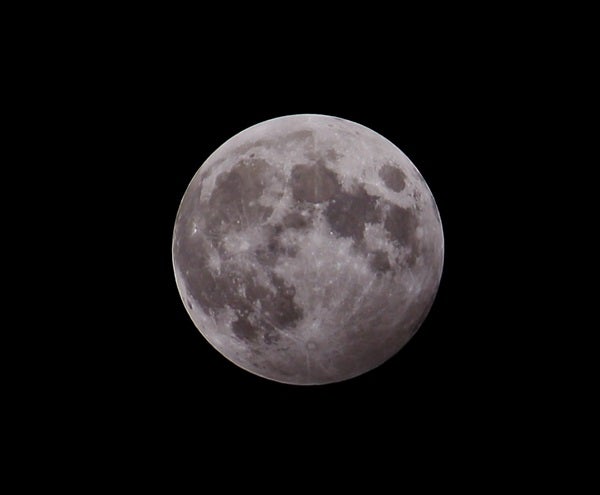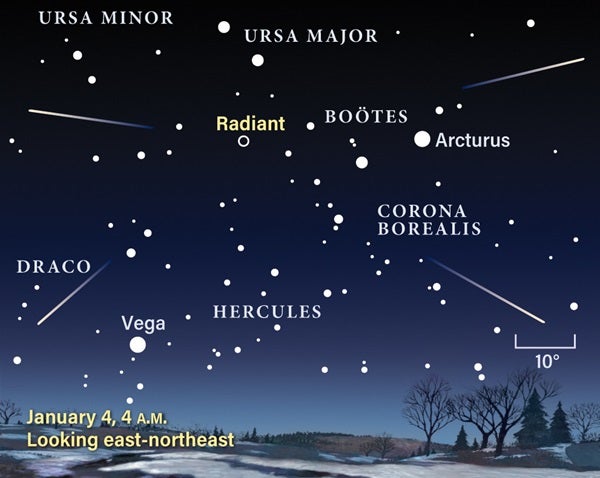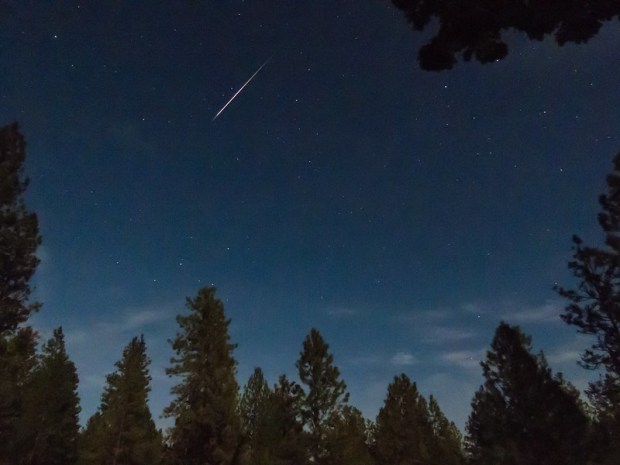A lone bright star now hangs low in the south-southwest during early evening. First-magnitude Fomalhaut — often called “the Solitary One” — belongs to the constellation Piscis Austrinus the Southern Fish. From mid-northern latitudes, it appears below the Great Square of Pegasus and nearly 20° above the horizon. How solitary is Fomalhaut? The nearest 1st-magnitude star to it, Achernar at the southern end of Eridanus the River, lies some 40° away.
The Quadrantid meteor shower reaches its peak this morning. The slightly gibbous Moon sets around 1 a.m. local time, leaving nearly five hours of darkness for watching. The Quadrantid shower typically produces up to 120 meteors per hour, an average of two per minute, so observers should be in for a great show if the weather cooperates. The meteors appear to radiate from a spot in the northern part of the constellation Boötes — an area once occupied by the now-defunct constellation Quadrans Muralis — a region that climbs highest just before dawn.
Sunday, January 5
Earth reaches perihelion, the closest point to the Sun during its year-long orbit, at 3 a.m. EST. The two then lie 91.4 million miles (147.1 million kilometers) apart. It surprises many people to learn that Earth comes closest to the Sun in the dead of winter, but the cold weather in the Northern Hemisphere at this time of year arises because the Sun lies low in the sky.
The Sun is in the news more than once today. Although people in the Northern Hemisphere experienced the shortest day of the year two weeks ago (at the winter solstice December 21), the Sun has continued to rise slightly later with each passing day. That trend stops this morning for those at 40° north latitude. Tomorrow’s sunrise will arrive a second earlier than today’s. This turnover point depends on latitude. If you live farther north, the switch occurred a few days ago; closer to the equator, the change won’t happen until later this month.
Monday, January 6
Venus gleams in the southwestern sky after sunset. The brilliant planet stands out just a half hour after sunset, when it appears 20° above the horizon, and remains on display until 7:30 p.m. local time. Shining at magnitude –4.0, it is by far the brightest point of light in the night sky. A telescope shows Venus’ disk, which spans 13″ and appears about 80 percent lit.
Tuesday, January 7
The brightest star in the sky (after the Sun, of course) puts on quite a show on January evenings. Gleaming at magnitude –1.5, Sirius shines nearly four times brighter than the next brightest star visible from mid-northern latitudes: Arcturus in the constellation Boötes. Sirius currently rises before 7 p.m. local time and ascends in the southeast throughout the evening hours.
Wednesday, January 8
If you’re game for a quick eveninφg challenge, try to spot Neptune through binoculars. The distant planet lies 30° high in the southwest near the end of evening twilight and doesn’t set until nearly 10 p.m. local time. The magnitude 7.9 world appears against the backdrop of Aquarius, 1.0° west-southwest of the 4th-magnitude star Phi (f) Aquarii. You’ll need binoculars to spy Neptune and a telescope to see its blue-gray disk, which spans 2.2″.
The solar system’s brightest asteroid is 4 Vesta, and it is conveniently located high in the early evening sky among the background stars of Cetus the Whale. Vesta glows at magnitude 7.5, which makes it a reasonably easy target through binoculars from the country and a snap to see with a small telescope from the suburbs. This week offers prime viewing because the asteroid lies near the 4th-magnitude star Mu (μ) Ceti. Tonight, you can spot Vesta just 0.5° southeast of this star. No other object brighter than the asteroid resides in its immediate vicinity.
Friday, January 10
Full Moon arrives officially at 2:21 p.m. EST, but it will look completely illuminated all night. You can find it rising in the east at sunset and peaking high in the south shortly after midnight local time. It dips low in the west by the time morning twilight begins. The Moon spends the night near the border between the constellations Gemini the Twins and Cancer the Crab. If you live in the Eastern Hemisphere, look carefully and you should notice the dusky shading of a penumbral lunar eclipse over Luna’s southern half. The eclipse peaks at 19h10m UT, when 92 percent of the Moon lies within our planet’s light outer shadow.
Mercury reaches superior conjunction at 10 a.m. EST. This means the innermost planet lies on the opposite side of the Sun from Earth and remains hidden in our star’s glare. It will return to view in the evening sky late this month.
Saturday, January 11
Uranus reached opposition and peak visibility in late October, but it remains a tempting target in January. The outer planet appears highest in the south once darkness falls, when it stands two-thirds of the way to the zenith. The magnitude 5.8 world lies in southwestern Aries the Ram, near that constellation’s border with Pisces the Fish and Cetus the Whale. Although Uranus shines brightly enough to glimpse with the naked eye from a dark site, binoculars will help your search immensely. The closest guide star is magnitude 4.4 Xi1 (ξ1) Ceti, which lies 4° to the southeast. A telescope reveals Uranus’ disk, which spans 3.6″ and shows a distinct blue-green hue.
Sunday, January 12
Ruddy Mars grows more prominent before dawn with each passing week. The Red Planet now rises just after 4 a.m. local time and climbs 20° above the southeastern horizon an hour before sunrise. Mars glows at magnitude 1.5 against the backdrop of Scorpius the Scorpion, some 6° north-northwest of its ancient rival, the 1st-magnitude star Antares. Unfortunately, a telescope doesn’t add much to the view, revealing a bland disk only 4″ across.












